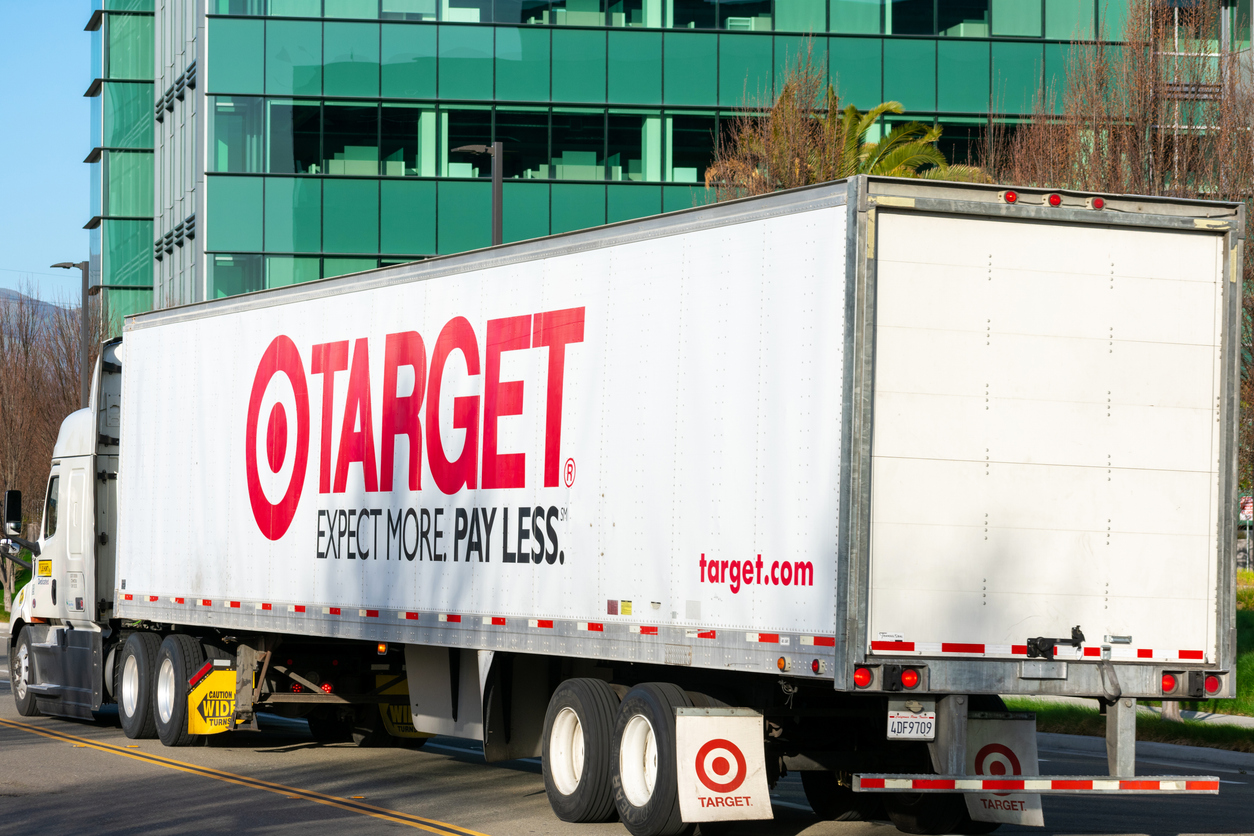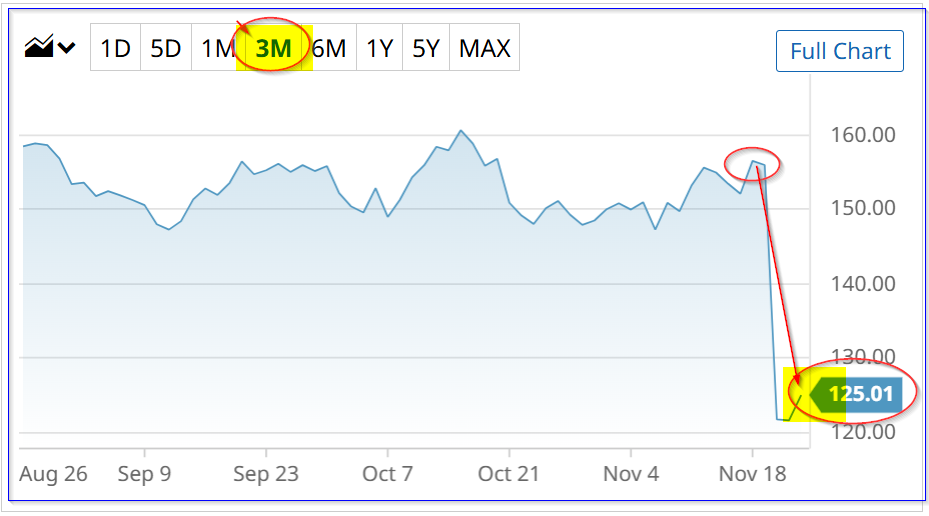
Has the recent 20% drop in Target Corp (TGT) stock been overdone? On Friday, Nov. 22, 2024, TGT started to rebound. One way to play this is long-dated TGT call options with in-the-money (ITM) strike prices.
TGT closed at $125.01 on Friday, up +2.42% from its day-before trough price of $121.59. This was a $34.59 or -22% decline from its price of $156.56 before its disappointing Nov. 20 Q3 earnings release.
I discussed this situation in my Nov. 20 Barchart article, “Target Stock Overreaction - Huge Unusual Put Option Volume Signals TGT's Drop is Overdone.” I argued that TGT was undervalued and worth at least $143 per share.

That means that even after Friday's gain, TGT stock is still worth 16% more. My valuation is based on the company's likely free cash flow (FCF) margins next year.
For example, based on analysts' forecasts of $109 billion in revenue next year, with a 2.0% FCF margin, free cash flow could be $2.18 billion. Even if FCF drops to $2.00 billion,TGT stock could be cheap. Here's why.
Using a 3.0% FCF yield, the market valuation would eventually be worth $66.67 billion:
$2.0b in est. FCF 2025 / 0.03 = $66.67 billion).
This is 16.1% higher than its market cap of $57.41 billion today.
$66.67b target mkt cap / $57.41 = 1.161
In other words, TGT stock is worth 16.1% more than $125.01:
1.161 x $125.01 = $145.13 per share
Other analysts see the stock as undervalued as well.
Analysts See TGT Stock Undervalued
For example, Yahoo! Finance says its survey of 37 analysts shows an average price target of $143.41 per share. That is close to my price target and still 14.7% higher than today's price.
In addition, Barchart's survey has a mean target price of $156.90 or 25.5% higher. Similarly, AnaChart.com, a new fintech site that tracks sell-side analysts and their price targets, shows that the average of 23 analysts is $153.95 per share, 23% higher than Friday's close.
The bottom line is that Target stock now looks undervalued. But it could take a good while for the stock to rebound. After all, investors are nervous that Target's holiday season might not turn out well.
Therefore, let's look at an alternative way to play TGT stock: buying long-dated call options with in-the-money (ITM) strike prices).
In-the-Money Long-Dated TGT Calls
For example, look at the Jan. 16, 2026 expiration call option chain. This is 421 days from now, or almost 1 year and 2 months away. That allows the investor to hold these calls over one year and potentially not have to pay short-term capital gains taxes on any profits.
Here is what is interesting. It makes sense to buy in-the-money (ITM) call options since these already have some intrinsic value embedded in their price. That provides some degree of downside protection as well as providing good leverage on the upside.
For example, look at the $110.00 strike price calls. These are trading $15.01 below the $125.01 trading price, and so are already worth at least that amount.

However, the midprice premium is $23.50, meaning there is $23.50-$15.01, or $8.49 of excess or extrinsic value in the price. But, at least the intrinsic value represents 64% of the total premium paid.
Upside and Leverage
Moreover, the advantage is that to buy 1 contract representing 100 shares the outlay is only $2,350 per call option. To buy 100 shares at today's trading price, the investor would have to pay $12,501 (i.e., $125.01 x 100). So, the investor gains 5.3x leverage (i.e., $125.01/$23.50).
In this regard, note that the delta ratio is 0.663. That implies that for every dollar increase in the trading price, the call option price will rise by 66.3% of that amount (same on the downside).
This could lead to a huge potential upside for the investor. For example, let's assume that in 6 months TGT is trading at $145. The intrinsic value will be $35.00:
$145.00 - $110.00 strike price = $35.00 intrinsic value
This is 49% higher than the premium paid today vs just a 16% gain in the stock:
$35.00 / $23.50 call price -1 = 1.49 -1 = +49%, vs. $145.00 /$125.01 -1 = 1.16 -1 = +16%
That is, the investor gains a 3 times leverage on the upside (i.e., 49%/16% = 3.0x). Moreover, remember that the delta ratio is 66.3%. This means that the premium will rise slightly higher than the intrinsic value:
$145 - $125.01 trading price = +$19.99 stock price gain x 0.663 = $13.25 increase in $110 call price; $23.50 + $13.25 = $36.75
That is 5% higher than the intrinsic value of $35.00 for the calls. So, in effect, the investor could make a 56.4% return:
$36.75 / $23.50 -1 = 1.5638 -1 = +56.4% upside.
Downside Risk
One advantage of the ITM feature of these calls is that there is some downside protection. For example, let's say that TGT stays flat over the next year. There is still some intrinsic value left in the calls, vs. losing 100% of the premium:
$125.01 trading price - $110.00 strike price = $15.01 intrinsic value.
That still means the investor will lose money on the investment (i.e., $15.01 - $23.50 paid = - $8.49, or -36.1%). But at least the investor will have both time and some investment money left to roll over.
Moreover, remember the delta ratio above. It limits the downside as well. For example, let's say in 6 months TGT stock is down $5.01 to $120.00. The premium of the call will have dropped about 66% of that amount, or $3.32:
$23.50 - (-$5.01 x 0.663) = $23.50 - $3.32 = $20.18
That represents a drop of 14% vs. a 4% drop in the trading price. But, at least it's not as bad as the $5.00 drop in the intrinsic value (i.e., $120 trading price -$110 strike price). That would be a drop of 21% (i.e., -$5.00/$23.50 premium paid) vs. the actual 14% drop in the premium. (BTW, one site to you project out downside risk is www.optionsprofitcalculator.com).
In other words, due to the time value remaining in these long-dated ITM calls, there is less downside than otherwise with intrinsic value calculations.
The bottom line is that long-dated in-the-money (ITM) call options are a good alternative way to play TGT stock's upside.



!["[T]he First and Fifth Amendments Require ICE to Provide Information About the Whereabouts of a Detained Person"](https://images.inkl.com/s3/publisher/cover/212/reason-cover.png?w=600)



